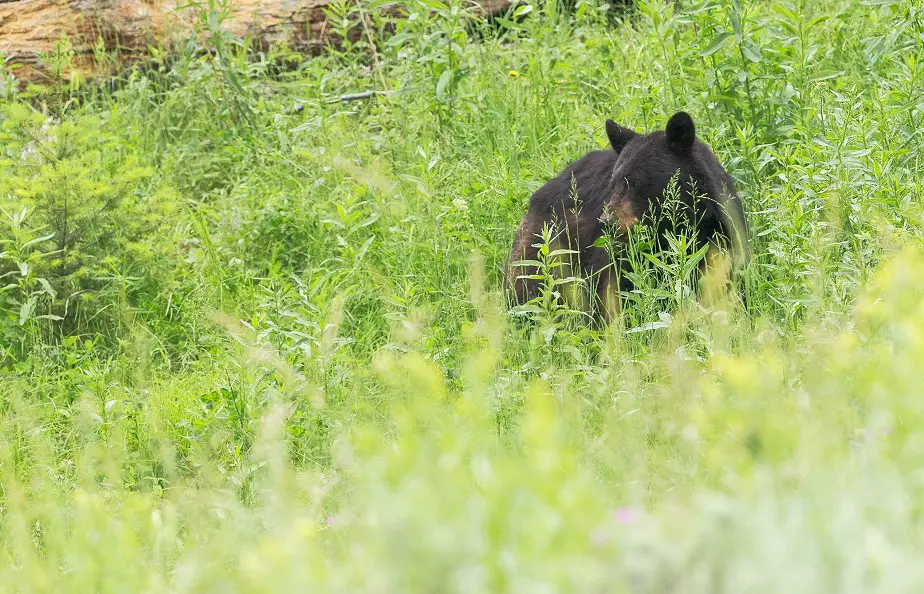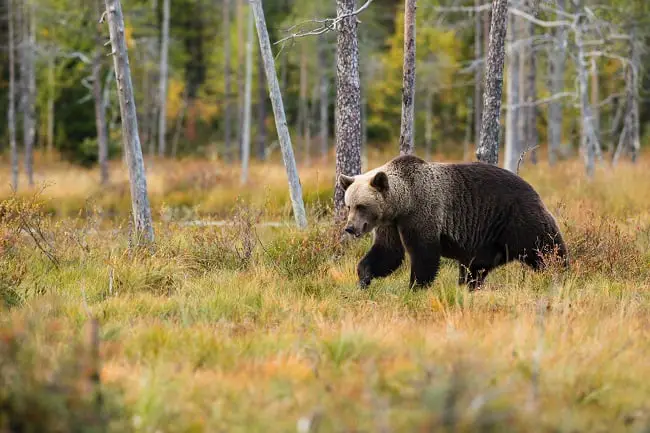Thanks to the increasing popularity of the modern sporting rifle, the .223 is the more popular than ever before, and is being successfully used in more applications than it was ever intended to.
A .223 can take small and medium bears under 150 yards. With good bullets, like BARNES copper TSX bullet, a hunter can reliably take a 300-pound bear. With good ammo and good shot placement, the 223 can be a functional choice for bear hunting.

223 for Bear Hunting
My Modern Sporting rifle chambered in .223 has become my favorite rifle. Since I got it, I have delved the dark depths of ballistic charts and ammo manufacturers to uncover all There is to know about the cartridge. I can say, I’m pretty darn well versed in the knowledge of the .223.
I’m going to use the term .223 and 5.56 as the same thing because, ballistically, they are identical. Don’t argue about it here, that’s a whole other issue. I’m sure I will address it soon in another post. It’s really quite simple, but like all things gun related, there’s tons of half information out there.
Anyway, on to the topic. I’ve met several people who have killed a bear with their .223. more specifically, an AR chambered in the cartridge. I make that distinction for a reason. The common barrel length for a bolt action rifle is 24 inches. That’s the length uses in most ballistics charts.
According to several charts I have on hand, the .223 has an average velocity of 3,250 and 1,300 ft/lbs. of energy from a 24-inch barrel. The standard AR barrel lengths of 16 and 18 inches can be expected to have about 3000 fps of velocity and 1,200-1,300 ft/lbs. of energy.
With either barrel length style, you will see good wounding capabilities up to 100 yards. When I say wounding, I don’t mean you will only wound the animal and not kill it. I am referring to the physical damage (wound channel) caused by the bullet.

Bear Hunt with a 223, Stories
Here is a link to a post on a forum where a hunter shot a bear with an AR chambered in .223.
https://www.calguns.net/calgunforum/showthread.php?t=355393
he shot it at about 75 yards. He fired twice and made two good hits. I’ll note that fast follow up shots and staying on target is a benefit of smaller lightweight calibers. In his words “Two 55gr poly tip shots cooked it’s lungs and heart. Pass thru with devastating internal damage. Everything inside is jelly. Died 10 yards from where it was initially shot”. His bear was a modest 250 pounds
Sound surprising? Well it’s not. That’s how the cartridge preforms. The high velocity of the .223 causes it to be devastating at close ranges in any instance where deep penetration is not required.
The lighter weight, 55 grain bullets tend to be completely destructive to soft tissue up to 10 inches deep.
It’s not a far trip through the hide of a bear, through the ribs, and into the lungs, and the lungs don’t offer much resistance to a bullet either. That is, if you get a broad side shot. At poor angles, you have to penetrate a lot more muscle and bone to reach the lungs. An ethical hunter who is willing to pass up on a bad shot will be able to make clean kills with a much smaller gun.
Using a .223 Defensively Against a Bear

If you are asking this question, I bet you are thinking more about defensive use than to use one for hunting. Many people see the AR as a very useful general-purpose gun. I advocate it’s about the best. If you have one, you are probably asking if you can use your .223 AR in a bad situation with a bear.
To that I say, any gun is better than no gun. there are hundreds of more powerful options out there, but that doesn’t mean you can’t if you have to. The .223 may be small, but compared to the common rifles 100 years ago, it’s none too shabby.
I would never advise someone in big bear country to have only a .223. If 400-pound bears are common, and all you have is a .223 AR, get another upper in 450 Bushmaster. If you are in grizzly territory, definitely look into a belted magnum at least 30 caliber and get the most powerful you can afford.
I’m going to give some interesting perspective now. The Inuit are a people that face large animals in a dangerous environment on a regular basis. Since the years after World War 1, the Inuit have adopted the use of the 303 British Enfield rifle. the 303 British is basically a mid-powered 30-06.
However, in recent years, they have taken to the .223 rifle, particularly a basic AR style rifle. The rifle is lightweight and the ammo is light weight. That’s worth a lot to people who have to carry a rifle across the frozen tundra every day. They regularly use them to take caribou and moose in the field with a head shot. And the ammo used it military FMJ, due to availability.
If you don’t think that a .223 will work with a head shot animals that size, listen up. In the 1960’s, the US army found in their testing that a 55 grain FMJ .223 fired from a 20-inch barrel will go through a steel army helmet at 600 yards.
Here is an interesting test of penetration
The Right 223 Ammo for Bears
The very best .223 ammo for bear is Black Hills 77 Grain match king hollow point. There is no comparison to effectiveness of this bullet on mid-sized game in the .223. It is simply the best
Where it’s legal, hunting with FMJ bullets can actually make sense with a .223. The m193, the 55 grain us military round, is perfectly suited for hunting medium sized game within a hundred yards. At high speeds, The bullet fragments rather nicely into a nasty wound. Hog hunters have been using these for decades on 200 plus pound hogs. It seems to work.
When the bullet velocity drops below 2,700 fps, it doesn’t do much. At that point, it’s just poking a small hole, similar to getting stuck with a nail. When the bullet is going over 2,800 fps, it preforms well. the higher the velocity, the more violent the wound channel will be.
Expanding ammo is less common with a .223 than other calibers. Still, there are two main types of controlled expansion bullets available. We have the solid copper Barnes bullet; Remington sells a load with it. it’s a good option too. We also have the classic soft point. There are several companies that sell these.
The controlled expansion bullets will penetrate better than the m193. They retain energy better because the bullet stays together better. Most states don’t allow hunting with FMJ ammo, even though some of them work perhaps better than expanding bullets.
The .223 has bullets from 40 grains up to 75 grains. Don’t consider anything under 55 grains. With a controlled expansion bullet, the heavier ones are generally better

